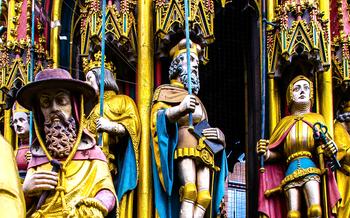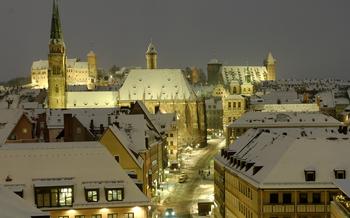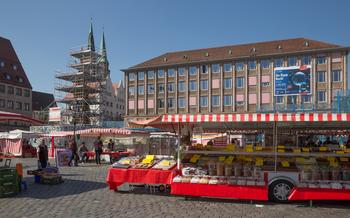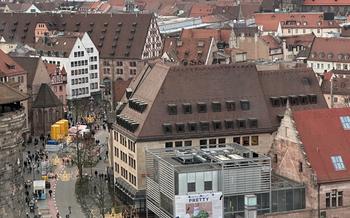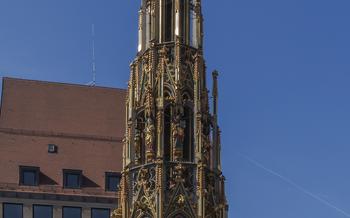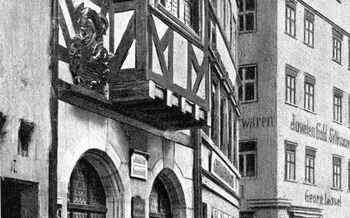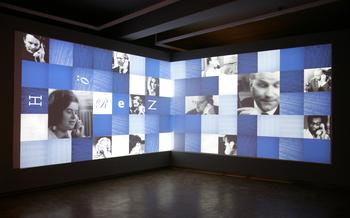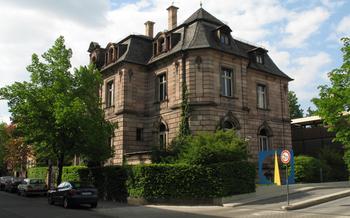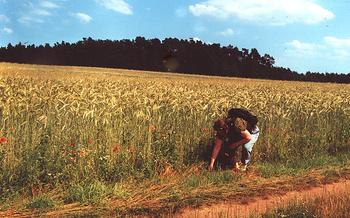
Tucher Mansion Museum (Museum Tucherschloss und Hirsvogelsaal)
- Tucher Mansion Museum: A Historical Gem in Nuremberg
- Exploring the Grand Hall: Hirsvogelsaal
- Tucher Mansion: A Symbol of Renaissance Architecture
- Interactive Exhibits for a Multisensory Experience
- The Tucher Family: A Legacy of Entrepreneurship
- Nuremberg's Rich Brewing History
- Tucher Mansion's Hidden Treasures
- Guided Tours for an In-Depth Experience
- Museum Shop for Unique Souvenirs
- Accessibility and Facilities for Visitors
- Transportation and Parking
- Nearby Attractions and Points of Interest
- Tucher Mansion in Pop Culture and Media
- Insider Tip: Off-the-Beaten-Path Experiences
Tucher Mansion Museum: A Historical Gem in Nuremberg
In the heart of Nuremberg's Old Town, nestled between cobbled streets and centuries-old buildings, stands the Tucher Mansion Museum, a testament to the city's rich history and cultural heritage. Once the grand residence of the prominent Tucher family, this magnificent edifice now houses a captivating museum that invites visitors on a journey through time.
The Tuchers, one of Nuremberg's most influential families, played a pivotal role in shaping the city's economic, political, and cultural landscape for over 600 years. Their legacy is intricately intertwined with the rise of Nuremberg as a thriving trade center and a hub of artistic innovation during the Renaissance era.
The Tucher Mansion Museum offers a glimpse into the opulent lifestyle and remarkable achievements of this prominent family. Through its diverse collection of artifacts, interactive exhibits, and stunning architecture, the museum provides a unique and immersive experience that transports visitors back in time to witness the grandeur of a bygone era.
Exploring the Grand Hall: Hirsvogelsaal
Step into the Hirsvogelsaal, the heart of the Tucher Mansion, and be captivated by the stunning ceiling paintings that adorn its grand interior. Created by the renowned artist Hans Sebald Beham in the 16th century, these masterpieces depict scenes from mythology, history, and religion, each brushstroke telling a captivating story.
The hall's intricate iconography reveals a wealth of symbolism and allegory, inviting visitors to decipher the hidden meanings behind the vivid imagery. Gaze up at the central panel, where the figure of Justice presides over a celestial court, surrounded by virtues and vices, reminding viewers of the moral choices that shape human destiny.
Beyond the painted ceiling, the Hirsvogelsaal boasts architectural features that harmonize seamlessly with the artistic splendor. Its impressive windows, adorned with stained glass panels, bathe the hall in a symphony of colored light, creating an ethereal atmosphere that enhances the overall sensory experience.
Throughout history, the Hirsvogelsaal has served as a grand setting for lavish banquets, official receptions, and important ceremonies. Its opulent ambiance and historical significance make it a truly special venue, where the past comes alive, and visitors can immerse themselves in the grandeur of Nuremberg's golden age.
Tucher Mansion: A Symbol of Renaissance Architecture
The Tucher Mansion stands as a remarkable example of Renaissance architecture, showcasing a blend of Italian influences and local craftsmanship. Its distinctive facade, adorned with intricate carvings and sculptures, reflects the opulence and artistry of the era. The mansion's design pays homage to the Italian Renaissance, featuring symmetrical proportions, classical motifs, and decorative elements that were popular during that period. The ornate decorations, including elaborate window frames, cornices, and pilasters, add to the building's grandeur and elegance. Local craftsmen and artists played a significant role in the mansion's construction, demonstrating their mastery and skill in translating Renaissance ideals into a tangible form. The result is a harmonious fusion of Italian inspiration and local craftsmanship, making the Tucher Mansion a unique architectural gem in Nuremberg, comparable to other notable Renaissance buildings in the city, such as the Albrecht Dürer House and the Fembo House.
Interactive Exhibits for a Multisensory Experience
The Tucher Mansion Museum offers a unique and engaging experience for visitors of all ages through its interactive exhibits. These exhibits bring history to life, allowing visitors to immerse themselves in the world of the Tucher family and the city of Nuremberg.
Multimedia displays, hands-on activities, and interactive games invite visitors to explore the museum's collection in a fun and engaging way. Through these interactive elements, visitors can learn about the Tucher family's history, their role in the city's development, and the significance of Nuremberg's brewing tradition.
Whether it's trying on replicas of historical costumes, playing interactive quizzes, or creating digital artwork inspired by the museum's collection, there's something for everyone to enjoy. These interactive exhibits make learning about history a truly immersive and memorable experience.
In addition to enhancing the visitor experience, these interactive elements help to break down barriers and make the museum more accessible to people of all backgrounds and learning styles. By providing a multisensory experience, the Tucher Mansion Museum ensures that visitors of all ages and abilities can engage with the past in a meaningful and enjoyable way.
The Tucher Family: A Legacy of Entrepreneurship
The rise of the Tucher family as prominent merchants and brewers in Nuremberg is a story of ambition, hard work, and innovation. Beginning in the 13th century, the Tuchers established themselves as successful traders, dealing in a wide range of goods, including spices, textiles, and precious metals. Their business acumen and extensive network of contacts allowed them to amass considerable wealth, which they invested in various industries, including brewing.
The Tucher family's brewing venture proved to be particularly fruitful. In 1440, they acquired the Tucherbräu brewery, which quickly became one of the most successful in Nuremberg. The Tuchers' expertise in brewing, combined with their shrewd business practices, enabled them to dominate the local beer market. Their beer, known for its exceptional quality and taste, became a favorite among the city's residents and visitors alike.
Beyond their business success, the Tuchers were also actively involved in politics and civic affairs. They held high-ranking positions in the city council and played a significant role in shaping Nuremberg's policies and development. Their influence extended to the cultural sphere as well, as they were patrons of the arts and sciences, supporting local artists and scholars.
The Tucher family's legacy is deeply intertwined with the history of Nuremberg. Their contributions to the city's economy, culture, and politics have left an indelible mark on its urban landscape. Stories and anecdotes about notable members of the family, such as Anton Tucher, who served as mayor of Nuremberg during the tumultuous 16th century, continue to be passed down from generation to generation, inspiring and captivating visitors to the Tucher Mansion Museum.
Nuremberg's Rich Brewing History
Nuremberg is renowned for its rich brewing tradition, which dates back to the Middle Ages. The city's geographical location, with its abundance of fresh water and barley, made it an ideal place for brewing. The Tucher family played a significant role in shaping Nuremberg's brewing industry.
Tucher's Brewing Legacy
The Tuchers were prominent merchants and brewers in Nuremberg, and their brewing skills were highly regarded. They owned several breweries in the city and were instrumental in establishing Nuremberg as a brewing center. The Tucher family's brewing techniques and recipes were passed down from generation to generation, contributing to the unique flavor and quality of Nuremberg's beer.
Nuremberg Beer: A Local Treasure
Nuremberg's beer is known for its distinctive taste and has become a symbol of the city. It is brewed according to the Reinheitsgebot, the German Beer Purity Law of 1516, which mandates that beer can only be made with water, barley, and hops. The local breweries have maintained this tradition, ensuring the authenticity and quality of Nuremberg's beer.
Breweries to Visit
Visitors to Nuremberg can explore the city's brewing heritage by visiting the Tucher Bräu brewery, which has been in operation since 167Guided tours of the brewery provide insights into the brewing process and allow visitors to sample the various beers produced by Tucher. Other notable breweries in Nuremberg include Hausbrauerei Altstadthof, Brauerei Barfüßer, and the Craft Beer Manufaktur Nürnberg.
Tucher Mansion's Hidden Treasures
Beyond the main exhibits and attractions, the Tucher Mansion holds a treasure trove of hidden gems that may escape the notice of casual visitors. Secret passageways, hidden rooms, and forgotten artifacts await those who venture off the beaten path and explore the mansion's hidden corners.
One of the most intriguing hidden treasures is the secret passageway that connects the mansion to the nearby St. Sebaldus Church. This passageway was once used by the Tucher family to attend church without having to brave the elements or face the public. Today, visitors can follow in their footsteps and experience the thrill of walking through this hidden tunnel.
Another hidden gem is the family's private chapel, located on the upper floor of the mansion. This intimate space is adorned with exquisite frescoes and stained glass windows, creating a serene and spiritual atmosphere. Visitors can admire the intricate artwork and imagine the Tuchers attending mass in this private sanctuary.
Among the forgotten artifacts in the mansion's collection is a rare collection of medieval manuscripts. These handwritten books offer a glimpse into the intellectual and cultural life of the Tucher family. Visitors can marvel at the beautiful calligraphy, intricate illustrations, and fascinating insights into the past.
Exploring these hidden treasures adds an extra layer of intrigue and discovery to a visit to the Tucher Mansion. Visitors who take the time to seek out these hidden gems will be rewarded with a deeper understanding of the mansion's history, its inhabitants, and their legacy.
Guided Tours for an In-Depth Experience
Embark on a journey through the past as you join a guided tour of the Tucher Mansion Museum. Led by knowledgeable guides, these tours offer an in-depth exploration of the mansion's rich history, architecture, and exhibits. With their expertise, guides provide insightful anecdotes and historical context that bring the museum's collection to life.
Different types of tours are available to cater to diverse interests. Thematic tours focus on specific aspects of the mansion, such as its Renaissance architecture or the Tucher family's legacy. Personalized tours can be arranged for groups or individuals seeking a tailored experience.
To make the most of your guided tour, consider booking in advance, especially during peak tourist seasons. This ensures your spot and allows you to choose your preferred date and time. During the tour, don't hesitate to ask questions and engage with your guide. Their insights will enhance your understanding and appreciation of the Tucher Mansion Museum.
Whether you're a history buff, an architecture enthusiast, or simply seeking a unique cultural experience, a guided tour of the Tucher Mansion Museum is an unforgettable journey into Nuremberg's past.
Museum Shop for Unique Souvenirs
The Tucher Mansion Museum houses a well-stocked museum shop that offers a diverse selection of souvenirs and merchandise inspired by the museum's collection and Nuremberg's rich history.
-
Books and Publications: Discover a range of books and publications that delve into the history of the Tucher family, the museum, and the city of Nuremberg. These books provide fascinating insights and serve as excellent souvenirs for history buffs and avid readers.
-
Postcards and Prints: Capture the beauty of the Tucher Mansion and its surroundings with a collection of postcards and prints. These high-quality reproductions of historical artwork and photographs make for lovely keepsakes or gifts for friends and family.
-
Replicas and Souvenirs: Take home a piece of history with replicas of artifacts from the museum's collection. These replicas range from miniature models of the Tucher Mansion to replicas of historical coins and jewelry.
-
Special Editions and Limited-Time Offers: Keep an eye out for special editions and limited-time offers at the museum shop. These exclusive items, often inspired by seasonal events or special exhibitions, make for truly unique souvenirs.
-
Tips for Souvenir Shopping:
- Plan Your Purchase: Before you start shopping, take some time to browse the museum's exhibits and decide which items you are interested in. This will help you narrow down your choices and make informed purchases.
- Support Local Artisans: Many of the souvenirs in the museum shop are handcrafted by local artisans. By purchasing these items, you not only support the local economy but also take home a truly unique souvenir.
- Check for Discounts: The museum shop occasionally offers discounts and special promotions, so be sure to inquire about these when making your purchase.
Accessibility and Facilities for Visitors
The Tucher Mansion Museum is committed to ensuring that all visitors have a comfortable and enjoyable experience. The museum is wheelchair accessible, with ramps, elevators, and accessible restrooms throughout the building.
-
Wheelchair accessibility: The museum is fully accessible for visitors using wheelchairs, with ramps, elevators, and accessible restrooms available.
-
Restrooms and lockers: Clean and well-maintained restrooms are available for visitors on all floors of the museum. Lockers are also available for storing personal belongings during your visit.
-
Child-friendly facilities: The museum offers several amenities to make it a welcoming environment for families with children. Strollers can be borrowed for free at the museum's entrance, and a changing room is available for parents' convenience.
-
Visually impaired visitors: The museum provides audio guides and tactile exhibits for visually impaired visitors to enhance their experience.
-
Hearing impaired visitors: Guided tours in sign language can be arranged upon request for hearing-impaired visitors. The museum also offers assistive listening devices for use during guided tours.
-
Special needs: The museum staff is happy to assist visitors with specific needs. Please contact the museum in advance to discuss your requirements.
Tips for visitors with disabilities:
-
Plan your visit: Before your visit, check the museum's website for information on accessibility and any special events or programs that may be of interest.
-
Book a guided tour: A guided tour is a great way to learn more about the museum's exhibits and history. Be sure to let the museum know if you require any special accommodations when booking your tour.
-
Take your time: The museum is a large and complex building, so take your time exploring and don't hesitate to ask a member of staff for assistance if you need it.
-
Enjoy the experience: The Tucher Mansion Museum is a fascinating and educational place to visit. With its many accessibility features and amenities, the museum is open to everyone to enjoy.
Transportation and Parking
The Tucher Mansion is conveniently located in the heart of Nuremberg, making it easily accessible by various modes of transportation. For those utilizing public transportation, numerous tram and bus lines stop within walking distance of the museum. The closest stop is "Lorenzkirche," served by tram lines 7 and
For visitors arriving by car, there are several parking options available. The closest parking garage is the "Parkhaus am Paniersplatz," located just a short walk from the museum. Street parking is also available in the surrounding area, but it can be limited during peak hours. To avoid traffic congestion, it is advisable to plan your visit outside of rush hours or utilize public transportation whenever possible.
Nearby Attractions and Points of Interest
The Tucher Mansion is situated within the heart of Nuremberg's historic center, offering visitors a wealth of nearby attractions and points of interest to explore. A short stroll from the museum, you'll find the magnificent Albrecht Dürer House, where the renowned Renaissance artist Albrecht Dürer lived and worked. For those interested in history, the German National Museum, located just a few minutes away, offers a comprehensive collection of artifacts and exhibits showcasing the city's rich past.
To experience the vibrant atmosphere of Nuremberg, head to the Hauptmarkt, the city's central square, where you can admire the Gothic beauty of the Frauenkirche church and the iconic Schöner Brunnen fountain. Here, you can also soak up the lively ambiance, browse local markets, and savor delicious Franconian cuisine at one of the many restaurants and cafes.
For a unique perspective of the city, climb the steps of the Nuremberg Castle, a majestic fortress perched atop a hill. Explore its ancient fortifications, admire breathtaking views of the cityscape, and learn about its fascinating history as the former residence of the Holy Roman Emperors.
Art enthusiasts will delight in the Neues Museum Nürnberg, which houses an impressive collection of modern and contemporary art. The museum's striking architecture and thought-provoking exhibitions offer a refreshing contrast to the city's historical treasures.
To experience Nuremberg's vibrant nightlife, venture to the trendy Gostenhof district, known for its lively bars, clubs, and restaurants. Here, you can mingle with locals, enjoy live music, and dance the night away in a vibrant atmosphere.
Whether you're a history buff, an art lover, or simply seeking a lively atmosphere, Nuremberg offers a captivating array of attractions and experiences to complement your visit to the Tucher Mansion Museum. Plan a day or two to fully immerse yourself in the city's rich cultural heritage and vibrant urban life.
Tucher Mansion in Pop Culture and Media
The Tucher Mansion has served as a backdrop for numerous works of art, literature, and media, immortalizing its significance in Nuremberg's cultural landscape. One notable example is the novel "The Tucher Family" by German author Simon Buchner, which vividly portrays the rise and fall of the Tucher dynasty. The book was later adapted into a popular television series, bringing the family's story to a wider audience.
In addition, the mansion's unique architecture and historical associations have attracted filmmakers and storytellers. It has been featured in several historical dramas and documentaries, including "The Nuremberg Trials" and "The Merchant of Nuremberg." These productions have shed light on the mansion's role in shaping the city's history and its enduring legacy.
The Tucher Mansion's captivating ambiance has also inspired contemporary artists and musicians. Local painters and photographers have captured its essence in their works, while musicians have composed pieces inspired by the family's history and the mansion's grandeur.
These cultural representations have played a significant role in raising awareness of the Tucher Mansion and its importance. They have contributed to the museum's popularity, attracting visitors who are drawn to its historical charm and cultural significance.
Insider Tip: Off-the-Beaten-Path Experiences
Beyond the main attractions of the Tucher Mansion Museum, there are hidden gems and lesser-known aspects that are worth exploring for a truly unique experience.
-
Secret Passageways and Hidden Rooms: The mansion is rumored to have secret passageways and hidden rooms that were once used by the Tucher family. While these areas are not accessible to the public, their existence adds an air of mystery and intrigue to the museum.
-
Unique Photo Spots: The Tucher Mansion offers several unique photo spots that are perfect for capturing memorable moments. The courtyard, with its beautiful fountain and Renaissance architecture, is a popular spot for taking photos. The Grand Hall, with its magnificent ceiling paintings, is another excellent spot for capturing the grandeur of the mansion.
-
Off-Peak Hours: To avoid the crowds and experience the museum at a more leisurely pace, consider visiting during off-peak hours. The museum is typically less crowded in the early morning or late afternoon.
-
Underrated Attractions in Nuremberg: Nuremberg is home to several underrated attractions that are worth exploring. The German National Museum, with its vast collection of art and artifacts, is a must-visit for history enthusiasts. The Albrecht Dürer House, where the famous Renaissance artist lived and worked, is another popular attraction.
Exploring these hidden gems and off-the-beaten-path experiences will give you a deeper appreciation for the Tucher Mansion Museum and the city of Nuremberg.
